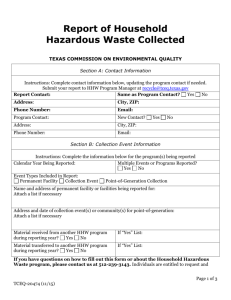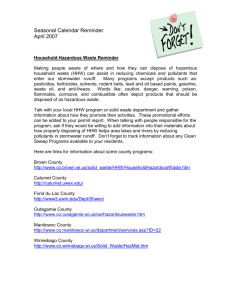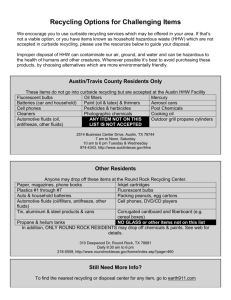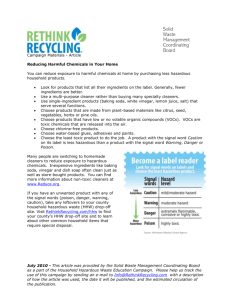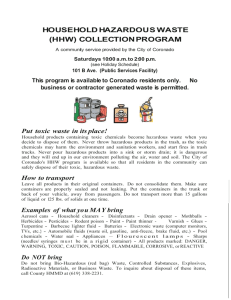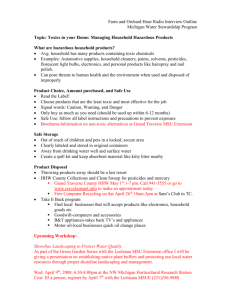local government
advertisement
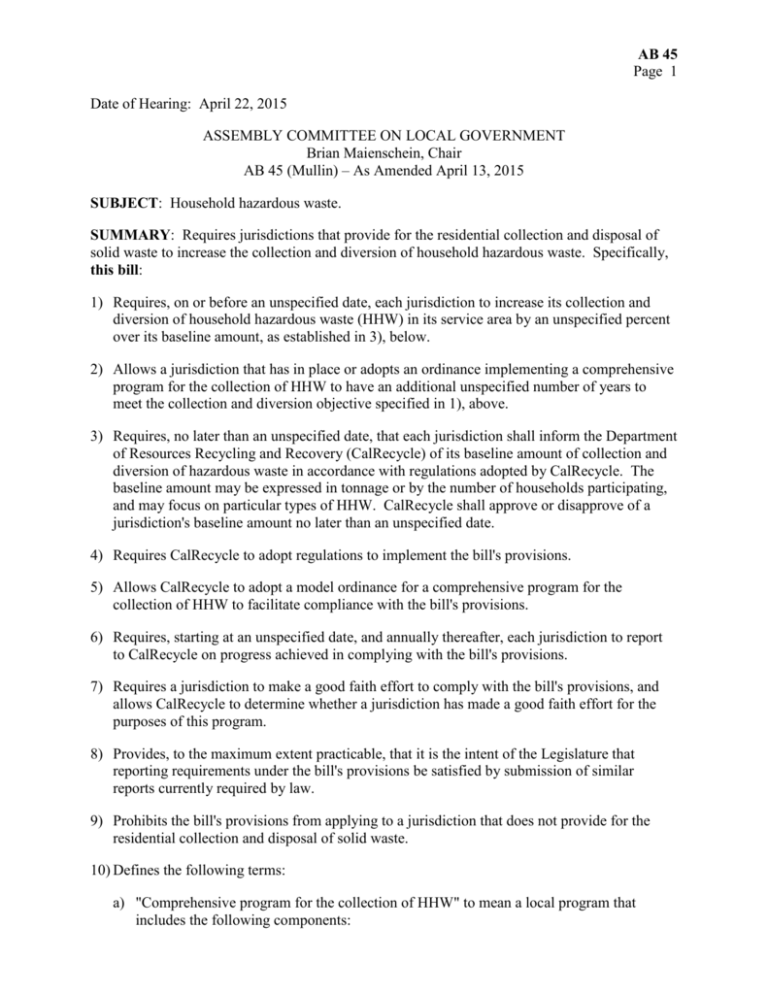
AB 45 Page 1 Date of Hearing: April 22, 2015 ASSEMBLY COMMITTEE ON LOCAL GOVERNMENT Brian Maienschein, Chair AB 45 (Mullin) – As Amended April 13, 2015 SUBJECT: Household hazardous waste. SUMMARY: Requires jurisdictions that provide for the residential collection and disposal of solid waste to increase the collection and diversion of household hazardous waste. Specifically, this bill: 1) Requires, on or before an unspecified date, each jurisdiction to increase its collection and diversion of household hazardous waste (HHW) in its service area by an unspecified percent over its baseline amount, as established in 3), below. 2) Allows a jurisdiction that has in place or adopts an ordinance implementing a comprehensive program for the collection of HHW to have an additional unspecified number of years to meet the collection and diversion objective specified in 1), above. 3) Requires, no later than an unspecified date, that each jurisdiction shall inform the Department of Resources Recycling and Recovery (CalRecycle) of its baseline amount of collection and diversion of hazardous waste in accordance with regulations adopted by CalRecycle. The baseline amount may be expressed in tonnage or by the number of households participating, and may focus on particular types of HHW. CalRecycle shall approve or disapprove of a jurisdiction's baseline amount no later than an unspecified date. 4) Requires CalRecycle to adopt regulations to implement the bill's provisions. 5) Allows CalRecycle to adopt a model ordinance for a comprehensive program for the collection of HHW to facilitate compliance with the bill's provisions. 6) Requires, starting at an unspecified date, and annually thereafter, each jurisdiction to report to CalRecycle on progress achieved in complying with the bill's provisions. 7) Requires a jurisdiction to make a good faith effort to comply with the bill's provisions, and allows CalRecycle to determine whether a jurisdiction has made a good faith effort for the purposes of this program. 8) Provides, to the maximum extent practicable, that it is the intent of the Legislature that reporting requirements under the bill's provisions be satisfied by submission of similar reports currently required by law. 9) Prohibits the bill's provisions from applying to a jurisdiction that does not provide for the residential collection and disposal of solid waste. 10) Defines the following terms: a) "Comprehensive program for the collection of HHW" to mean a local program that includes the following components: AB 45 Page 2 i) Utilization of locally sponsored collection sites; ii) Scheduled and publicly advertised drop off days; iii) Door-to-door collection programs; iv) Mobile collection programs; v) Dissemination of information about how consumers should dispose of the various types of HHW; and, vi) Education programs to promote consumer understanding and sue of the local components of a comprehensive program. b) "HHW" includes, but is not limited to, the following: i) Automotive products, including, but not limited to, antifreeze, batteries, brake fluid, motor oil, oil filters, fuels, was, and polish; ii) Garden chemicals, including, but not limited to, fertilizers, herbicides, insect spray, pesticides, and weed killers; iii) Household chemicals, including, but not limited to, ammonia, cleaners, strippers, and rust removers; iv) Paint products, including, but not limited to, paint, caulk, glue, stripper, thinner, and wood preservatives and stain; v) Consumer electronics, including, but not limited to, televisions, computers, laptops, monitors, keyboards, DVD and CD players, VCRs, MP3 players, cell phones, desktop printers, scanners, fax machines, mouses, microwaves, and related cords; vi) Swimming pool chemicals, including, but not limited to, chlorine tablets and liquids, pool acids, and stabilizers; vii) Household batteries. For purposes of this section, "household batteries" means batteries that individually weigh two kilograms or less of mercury, alkaline, carbonzinc, or nickel-cadmium, and any other batteries typically generated as household waste, including, but not limited to, batteries used to provide power for consumer electronic and personal goods often found in a household; viii) Fluorescent tubes and compact florescent lamps; ix) Mercury-containing items, including, but not limited to, thermometers, thermostats, and switches; x) Home-generated sharps waste, as defined in existing law; and, xi) Home-generated pharmaceutical waste. For purposes of this section, "homegenerated pharmaceutical waste" means a prescription or nonprescription drug, as specified, that is a waste generated by a household or households. "Home-generated AB 45 Page 3 pharmaceutical waste" shall not include drugs for which producers provide a takeback program as a part of a United States Food and Drug Administration managed risk evaluation and mitigation strategy pursuant to Section 355-1 of Title 21 of the United States Code, or waste generated by a business, corporation, limited partnership, or an entity involved in a wholesale transaction between a distributer and a retailer. 11) States that the Legislature finds and declares all of the following: a) HHW is creating environmental, health, and workplace safety issues. Whether due to unused pharmaceuticals, batteries, medical devices, or other disposable consumer items, effective and efficient disposal remains an extraordinary challenge. b) State and local efforts to address disposal of these items have been well intended and, in some cases, effective. However, even the most effective programs have very low consumer participation. Other approaches being promoted throughout the state would fragment the collection of HHW and move collection away from consumer convenience. c) In addition to other programs for the collection of HHW, a number of cities in California are already using curbside HHW collection program, door-to-door HHW collection programs, and HHW residential pickup services as mechanisms for collecting and disposing of many commonly used household items for which disposal has been the subject of state legislation or local ordinances. The waste disposal companies and local governments that have implemented these programs have found them to be valuable components of a comprehensive approach to the management of HHW. d) There is also an appropriate role for manufacturers and distributors of these products in comprehensive efforts to more effectively manage HHW. That role should be based on the ability of manufacturers and distributors to communicate with consumers. e) It is the intent of the Legislature to enact legislation that would establish curbside HHW collection programs, door-to-door HHW collection programs, and HHW residential pickup services as the principal means of collecting HHW and diverting it from California's landfills and waterways. 12) States that no reimbursement is required because a local agency or school district has the authority to levy service charges, fees, or assessments sufficient to pay for the program or level of services mandated by this act. EXISTING LAW: 1) Requires, under the California Integrated Waste Management Act of 1989, each city or county to divert 50 percent of solid waste from landfill disposal or transformation on and after January 1, 2000. Establishes a statewide policy goal that not less than 75 percent of solid waste be source reduced, recycled, or composted on and after January 1, 2020. 2) Requires cities and counties to prepare, adopt, and submit to CalRecycle an HHW Element plan which identifies a program for the safe collection, recycling, treatment, and disposal of hazardous wastes that are generated by households within the jurisdiction and provides a specific time frame for achieving these objectives. AB 45 Page 4 3) Requires CalRecycle and the Department of Toxic Substance Control (DTSC) to jointly maintain a database of all household hazardous waste collection events, facilities, and programs within the state and make that information available to the public upon request. 4) Establishes the California Oil Recycling Enhancement Act, which requires manufacturers of used oil to pay a fee of 4 cents per quart (16 cents per gallon) to the Department of Resources Recycling and Recovery (CalRecycle), which then pays a recycling incentive of 4 cents per quart to industrial generators, curbside collection program operators, and certified used oil collection centers for used oil collected from the public and transported for recycling. 5) Establishes the Electronic Waste Recycling Act of 2003, which requires a retailer selling a covered electronic device (CED) in California to collect a recycling fee (between $3 and $5) from the consumer. Fees are deposited into the Electronic Waste Recovery and Recycling Account, which is continuously appropriated to CalRecycle and the DTSC to make electronic waste recovery payments to cover the net cost of an authorized collector in operating a "free and convenient" system for collecting, consolidating, and transporting CEDs, and to make electronic waste recycling payments to cover an electronic waste recycler's average net cost of receiving, processing, and recycling CEDs. Defines CED as a product that contains a video display device 4 inches and larger. 6) Establishes the Cell Phone Recycling Act, which requires every retailer of cell phones to have in place a system for the acceptance and collection of used cell phones for reuse, recycling, or proper disposal. 7) Establishes the Rechargeable Battery Recycling Act, which requires every retailer of rechargeable batteries to have in place a system for the acceptance and collection of used rechargeable batteries for reuse, recycling, or proper disposal. 8) Establishes the Dry Cell Battery Management Act, which establishes requirements for the production and labeling of consumer products with dry cell batteries and sets limits on the amount of mercury in those batteries. 9) Establishes the Mercury Thermostat Collection Act, which requires manufacturers to establish and maintain a program for mercury-added thermostats. Requires the program to include collection, handling, and arranging for appropriate management of mercury-added thermostats. 10) Requires pharmaceutical manufacturers that sell or distribute a medication in California that is usually self-injected at home with a hypodermic needle to submit to CalRecycle a plan that describes any actions taken by the manufacturer for the safe collection and proper disposal of the waste devices. 11) Establishes the Architectural Paint Recovery Program, which requires architectural paint manufacturers to develop and implement a program to manage waste latex paint. 12) Prohibits the disposal of home-generated sharps waste in solid waste or recycling streams and requires pharmaceutical manufacturers that sell or distribute a medication in California that is self-injected at home through the use of a hypodermic needle, pen needle, intravenous AB 45 Page 5 needle, or any other similar device to annually submit a plan to CalRecycle that describes what actions, if any, the manufacturer supports for the safe management of sharps waste. FISCAL EFFECT: This bill is keyed fiscal and contains a state-mandated local program. COMMENTS: 1) Bill Summary. This bill requires jurisdictions that provide for the residential collection and disposal of solid waste to increase the collection and diversion of household hazardous waste by an unspecified percentage over a baseline amount. The bill requires each jurisdiction to inform CalRecycle of its baseline amount of collection and diversion of hazardous waste in accordance with regulations adopted by CalRecycle, by an unspecified date, and requires CalRecycle to approve or disapprove of a jurisdiction's baseline amount by an unspecified date. A jurisdiction that has in place or adopts an ordinance implementing a comprehensive program for the collection of HHW will have an unspecified number of additional years to meet the collection and diversion objectives specified in the bill. The bill also allows CalRecycle to adopt a model ordinance for a comprehensive program for the collection of HHW to facilitate compliance with the bill's provisions. This bill is an author-sponsored measure. 2) Background on HHW. HHW is hazardous waste commonly generated by households and includes such ubiquitous items as batteries, pesticides, electronics, fluorescent lamps, used oil, solvents, and cleaners. If these products are handled or disposed of incorrectly, they can pose a threat to health and safety and the environment. When these products are discarded, they become "household hazardous waste." In California, it is illegal to dispose of HHW in the trash, down the drain, or by abandonment. HHW needs to be disposed of through a HHW program. While there are many different approaches to the collection and management of HHW, all are permitted by DTSC and most are operated by local jurisdictions. Some private operators operate programs under contract with local jurisdictions, including curbside and door-to-door collection. Many common products that are used in daily lives contain potentially hazardous ingredients and require special care when disposed of. It is illegal to dispose of hazardous waste in the garbage, down storm drains, or onto the ground. HHW are a wide range of products, including lights bulbs, batteries, electronics, fluorescent lamps tubes, mercury-containing items, electronic devices, acids, oxidizers, pesticides, paints, solvents and other products that pose an environmental threat. 3) Types of HHW Programs: a) Permanent Household Hazardous Waste Collection Facilities (PHHWCFs). PHHWCFs are HHW collection facilities operated by a public agency on a continuous, regular schedule and housed in a permanent or semi-permanent structure at a fixed location. The HHW collected at the PHHWCF can only be stored at the facility for one year. Wastes are routinely taken for recycling or disposal, and no wastes are allowed to remain at the facility for more than one year after the date of collection. These facilities are authorized under Permit by Rule (PBR) by the local jurisdiction, according to regulatory standards adopted by DTSC. AB 45 Page 6 b) Curbside Collection. Curbside HHW collection programs may be operated by public agencies to collect one or more of the following types of HHW: used oil and filters, latex paint, batteries, electronic wastes, and cell phones. Curbside collection programs require authorization and are operated according to the requirements established in the HHW law. c) Door-to-Door/Residential Collections. Residential (door-to-door) HHW collection programs are a subset of the HHW program and are operated by public agencies to collect household hazardous wastes directly from individual residences. Business waste generated by a home-based business may not be collected by a door-to-door program. The collected wastes are then transported to an authorized HHW collection facility. Wastes to be collected by a door-to-door program must be kept in a secure environment by the resident and may not be left where they may be accessed by the public, such as the sidewalk or curbside. 4) Product Stewardship and Extended Producer Responsibility (EPR). Product stewardship refers to a policy model that includes manufacturers in the end-of-life management for products that they produce. The California Product Stewardship Council states that EPR is a strategy to place a shared responsibility for end-of-life product management on all entities involved in the product chain, instead of the local governments and taxpayers, while encouraging product design changes that minimize a negative impact on human health and the environment at every stage of a product's lifecycle. Ideally, EPR allows the costs of management and disposal to be incorporated into the total cost of a product. Good EPR programs result in products that are better designed for reuse and recycling, make recycling more convenient for consumers, reduce illegal disposal of hazardous materials, and encourage the use of recycled materials in new products. In 2007, CalRecycle adopted strategic directives to guide solid waste management in California. Strategic Directive 5: Producer Responsibility states that "it is a core value of [CalRecycle] that producers assume the responsibility for the safe stewardship of their materials in order to promote environmental sustainability." 5) Author's Statement. According to the author, "Many common household products such as antifreeze, drain cleaners, household batteries, electronics, glue and adhesives, household cleaners, paints, pesticides, pool cleaners, solvents, sharps and products containing mercury (thermometers, fluorescent lights, etc.) are hazardous. If these products are handled or disposed of incorrectly, they can pose a threat to human health, animals and the environment. When these products are discarded, they become "household hazardous waste" (HHW). "CalRecycle’s 2008 Waste Characterization Study (2014 data will be available in May of 2015) estimates that California residents throw away approximately 120,379 tons of household hazardous waste (HHW and E-Waste) annually. In California, it is illegal to dispose of HHW in the trash, down the drain, or by abandonment. "Ultimately the goal of the bill is to increase the diversion/reduction of HHW from the regular waste stream. Two important factors have been identified in the scientific literature looking at HHW disposal behavior – convenience and knowledge of appropriate disposal. AB 45 Page 7 "In 1989, landmark legislation (AB 939 by Assemblymember Sher) was enacted that, among other things, required local jurisdictions to “divert” 50% of all solid waste from landfill disposal through source reduction, recycling, and related activity by January 1, 2000. The “AB 939 Diversion” program is heralded as an environmental and economic success. The law has conserved landfill capacity, created green jobs and businesses, reduced greenhouse gases, conserved natural resources, and contributed to the fight against climate change. As much as any law enacted in California, AB 939 has contributed to the modern environmental ethic of stewardship. "AB 45 borrows from the demonstrably successful “diversion” laws and programs described above and requires local jurisdictions to “divert” a yet to be determined percentage of HHW from landfills by 2020. Local jurisdictions that deploy convenient comprehensive residential collection programs will be given more time to achieve the diversion objective." 6) Previous Legislation. AB 2371 (Mullin) of 2014, as heard by this Committee, would have required each jurisdiction, no later than January 1, 2016, to review its HHW Element to determine its effectiveness in the collection, recycling, treatment, and disposal of household hazardous waste. The bill additionally would have required CalRecycle, on or before January 1, 2017, to submit a report to the Legislature that analyzes the effectiveness of the state's household hazardous waste management system, and identify certain factors for CalRecycle to consider in that report. The bill was later amended to deal with a different subject matter. 7) Related Legislation. AB 1159 (Gordon), pending in the Environmental Safety and Toxic Materials Committee, would establish a pilot product stewardship program for the management of medical sharps and household primary batteries. 8) Policy Considerations. The Committee may wish to consider the following: a) Blanks. The Committee may wish to ask the author what he intends to specify in the following blanks in the bill: i) 47121 (a)(1). On or before _____, each jurisdiction shall increase its collection and diversion of HHW in its service area by _____ percent over its baseline amount, as established in subdivision (b). ii) 47121 (a)(2). Notwithstanding paragraph (1), a jurisdiction that has in place or adopts an ordinance implementing a comprehensive program for the collection of household hazardous waste shall have an additional _____years to meet the collection and diversion objective in paragraph (1). iii) 47121 (b). No later than ____, each jurisdiction shall inform the department of its baseline amount of collection and diversion of hazardous waste in accordance with regulations adopted by the department. The baseline amount may be expressed in tonnage or by the number of households participating, and may focus on particular types of household hazardous waste. The department shall approve or disapprove of a jurisdiction's baseline amount no later than _____. iv) 47123. Commencing _____, and annually thereafter, each jurisdiction shall report to the department on progress achieved in complying with this section. AB 45 Page 8 b) Local Control. According to the Solid Waste Association of Northern California, in opposition, "Jurisdictions across the state have invested in infrastructure and collection programs to provide different forms of convenience to residents. Some cities and counties have permanent facilities, some have mobile roundup events, and some have a combination of both types of collection opportunities. Several jurisdictions have residential curbside or door-to-door collection, particularly for the elderly and disabled population. Certain jurisdictions have also implemented a variety of approaches that include the collection of sharps at convalescent homes, batteries at public libraries, pharmaceuticals at law enforcement offices, and used marine oil at ports. This local flexibility is a fundamental tenet of the Integrated Waste Management Act, including for HHW programs. These existing HHW collection programs are robust, comprehensive, cost effective, and tailored for the communities served by the jurisdictions." c) Right Approach? The California State Association of Counties (CSAC), in opposition, writes that CSAC "strongly supports the concept of EPR. While this model may not be appropriate for all products, EPR is an excellent tool to employ for the producers of toxic and expensive-to-manage products, requiring the industries that profit from the products to have a stake in their proper management and disposal. Furthermore, this model incentivizes producers to incorporate environmental considerations in their design process, creating healthier products that are less toxic to our environment. "We believe that AB 45 would have the opposite effect on California's HHW management system. Requiring local jurisdictions to create a HHW baseline amount, which would be used to calculate an unspecified diversion mandate, removes all incentive for the creation of additional EPR programs in California. HHW management is a very expensive process as these toxic products require very specific handling and local governments and taxpayers should not have to bear the entire burden of managing these products. Furthermore, HHW is much different than municipal solid waste and creating targets for division is more complicated than household garbage. HHW includes a number of different products, including fluorescent lamps and tubes, various chemicals, sharps, pharmaceuticals and more. Households consume varying amounts of these types of products and hold onto them for varying amounts of time, thus making the development of a baseline difficult." Additionally, the California Product Stewardship Council (CPSC), in opposition, writes that "CPSC is concerned that a mandate on local governments, who are already technically required to divert 100 percent of HHW from landfills, will create resource pressures on local governments in order to divert a relatively minor, but very concerning, portion of the waste stream which likely will dramatically increase garbage rates and/or taxes. "While we support a policy known as 'Extended Producer Responsibility'….we have always been open to discussing alternative solutions that provide for a sharing of the responsibility between local governments, manufacturers, and others. Our opposition to AB 45 is based on the fact that the bill currently places all of the responsibility on local governments without any sharing of responsibilities." AB 45 Page 9 9) Arguments in Support. Eli Lilly and Company supports the bill if it is amended "to expressly pre-empt local ordinances that mandate the collection of household waste including the collection of home generated sharps or prescription or non-prescription medicines." 10) Arguments in Opposition. Opponents argue that this bill will not substantially increase participation in HHW collection, but will significantly increase costs to local government, and erode the path to EPR that is now supported by many cities and counties within California. 11) Double-Referral. This bill is double-referred to the Environmental Safety and Toxic Materials Committee. REGISTERED SUPPORT / OPPOSITION: Support Eli Lilly and Company (If Amended) Opposition Alameda County Board of Supervisors (In Concept) California Product Stewardship Council California State Association of Counties Cities of Burbank, Diamond Bar, Lawndale, Paramount, Roseville, Santa Monica, and Torrance Counties of San Bernardino and Tulare Marin County Board of Supervisors Lincoln Police Department Los Angeles County (Concerns) Los Angeles County Integrated Waste Management Task Force Rocklin Police Department Roseville Police Chief Rural County Representatives of California Placer County Board of Supervisors Sacramento County Board of Supervisors Santa Clara County Board of Supervisors Solid Waste Association of North America, California Chapters Stanislaus County Board of Supervisors Urban Counties Caucus Western Pacer Waste Management Authority Analysis Prepared by: Debbie Michel / L. GOV. / (916) 319-3958
